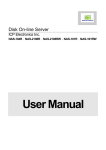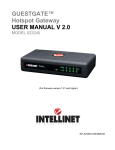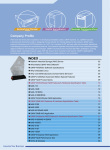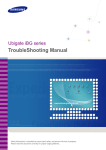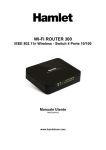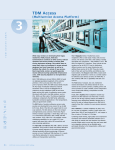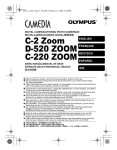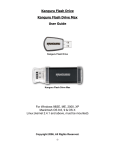Download Kanguru Solutions iNAS-100 User's Manual
Transcript
BROADBAND NETWORK ATTACHED STORAGE Kanguru iNAS-100 User’s Manual Copyright 2003, All Rights Reserved. This manual applies to 2.12 or later versions of the Kanguru iNAS 100 CUSTOMER SERVICE 1 To obtain service or technical support for your system, please contact Kanguru Solutions Technical Support Department at 508-376-4245, or visit www.Kanguru.com for web support. TRADEMARKS Microsoft®, Windows® and Internet Explorer® are registered trademarks of Microsoft Inc. Novell® and NetWare® are registered trademarks of Novell Inc. Apple® and Macintosh® are registered trademarks of Apple Computer Inc. All other brand or product names are trademarks of their respective companies or organizations. Copyright© 2003, Kanguru Solutions. All rights reserved. LIMITED WARRANTY Kanguru Solutions guarantees that every Kanguru iNAS-100 will be free from defects in workmanship and materials for 1 year from the date of purchase. This warranty does not apply if, in the judgment of Kanguru Solutions, the product fails due to damage from handling, accident, abuse, misuse, or if it has been used in a manner not conforming to the product’s instructions, has been modified in anyway, or the warranty labels have been removed. If the product proves defective during this warranty period, call Kanguru Solutions Technical Support in order to obtain a RMA required for service. When returning a product, mark the RMA number clearly on the outside of the package, and include a copy of your original proof of purchase. In no event shall Kanguru Solutions’ liability exceed the price paid for the product from direct, indirect, special, incidental, or consequential software, or its documentation. Kanguru Solutions offers no refunds for its products. Kanguru Solutions makes no warranty or representation, expressed, implied, or statutory, with respect to its products or the contents or use of this documentation and all accompanying software, and specifically disclaims its quality, performance, merchantability, or fitness for any particular purpose. Kanguru Solutions reserves the right to revise or update its products, software, or documentation without obligation to notify any individual or entity. FCC STATEMENT The Kanguru iNAS-100 has been tested and found to comply with the limits for a Class B digital device, pursuant to Part 15 of the FCC Rules. These limits are designed to provide reasonable protection against harmful interference in a residential installation. This equipment generates, uses, and can radiate radio frequency energy and, if not installed and used according to the instructions, may cause harmful interference to radio communications. However, there is no guarantee that interference will not occur in a particular installation. If this equipment does cause harmful interference to radio or television reception, which is found by turning the equipment off and on, the user is encouraged to try to correct the interference by one or more of the following measures: Reorient or relocate the receiving antenna Increase the separation between the equipment or device Connect the equipment to an outlet other than the receiver’s Consult a dealer or an experienced radio/TV technician for assistance 2 Table of Contents CHAPTER 1 Overview of the Kanguru iNAS 100 ......................................................................... 5 Introduction...............................................................................................................5 Features.....................................................................................................................5 Package Contents......................................................................................................5 Specifications............................................................................................................6 CHAPTER 2 Installing the Kanguru iNAS 100 .............................................................................. 9 First Time Installation...............................................................................................9 Quick Configuration ...............................................................................................10 iNAS Administration ..............................................................................................14 Connecting the iNAS as a NAS device...................................................................16 Connecting the iNAS as a Router. ..........................................................................19 Configuring a Router for the iNAS.........................................................................21 CHAPTER 3 User Management Management...................................................................................................... 22 Users .......................................................................................................................22 Network Share Management...................................................................................24 CHAPTER 5 System Settings ......................................................................................................... 26 Network Settings.....................................................................................................27 Disk Configuration .................................................................................................31 System Tools...........................................................................................................32 Statistics & Logs.....................................................................................................33 Server Administration.............................................................................................33 CHAPTER 6 Using the iNAS .......................................................................................................... 35 Accessing the iNAS through the Web ....................................................................35 Accessing the iNAS through a LAN.......................................................................36 Using the Apple Mac Operating System.................................................................38 Using the Unix/Linux Operating System................................................................43 Using Novell NetWare............................................................................................43 Using File Transfer Protocol (FTP) ........................................................................43 CHAPTER 7 Troubleshooting Troubleshooting......................................................................................................... 44 CHAPTER 8 Kanguru iNAS 100 - Maintenance .......................................................................... 45 Shutdown/Restart the Server...................................................................................45 3 Reset the Administrator Password & Network Settings .........................................45 Disk Failure or Malfunction....................................................................................46 Power Outage or Abnormal Shutdown ...................................................................46 Appendix A LCD Panel ................................................................................................................. 47 Displayed Information ............................................................................................47 Checking IP Address, System and Disk Information..............................................47 System Setup Function ...........................................................................................47 Appendix B Web File Manager .................................................................................................... 49 Using Web File Manager ........................................................................................49 Web File Manager Icons.........................................................................................51 Appendix C Quick Install Wizard Wizard................................................................................................. 52 Introduction.............................................................................................................52 Screenshot...............................................................................................................52 Operation Help........................................................................................................53 Appendix D Registering a Dynamic Domain Name Name..................................................................... 55 Introduction.............................................................................................................55 Registration Procedure............................................................................................55 4 1 Chapter Overview of the Kanguru iNAS 100 Introduction Thank you for choosing the Kanguru iNAS 100 from Kanguru Solutions. You can now quickly and easily add up to 250 GB of storage to your network with the Kanguru iNAS-100. The iNAS is a stand-alone Network Attached Storage device that can be accessed over your LAN or remotely over the Internet to share files. The iNAS requires very little administration support and can be setup within minutes. Simply plug in the power supply, connect the RJ-45 Ethernet, turn the power on, and the iNAS is instantly recognized by your network. An easy to use Administration page allows you to define users, user groups, set passwords, permissions, and quotas to control who has access to the files on your iNAS. Small office/home office users can use the iNAS as a file server handling sharing, backup and archiving for all kinds of files. The iNAS has a built in 4 port router to setup a small network and a LCD screen that displays the status for easy troubleshooting. Features • • • • • • • • Quickly and easily add up to 250 GB of storage to you network. Built-in 4 port router and firewall User-friendly web based interface for a step by step configuration Remote file upload/download via HTTP (web browsers) or FTP Automatically recognizes and supports all major network platforms such as Windows, Linux, Macintosh, and Unix. Remote access through Internet browser. Define users, groups, permissions, quotas, etc. Built-in DHCP, DNS Servers, and DDNS Support Package Contents • • • • • • Kanguru iNAS 100 User’s Manual Power Cord One CAT 5 Network Cable Manual and NasClient on Mini-CD Warranty/Registration Card 5 Specifications System Specification CPU NS Geode SC2200 266Mhz Flash Memory 16MB DRAM 128MB HDD 1 x 3.5" IDE HDD NASWare Router Edition Software System Information Network Specification Physical Specification Operation Environment LED Indicator Link/Act, 10/100M LCD Display LCD High Brightness Panel Two control Buttons for System Management Alarm Buzzer System Malfunction Warning Network Standards IEEE802.3 10 Base-T Ethernet IEEE802.3u 100 Base-TX Fast Ethernet IEEE802.3x Flow Control IEEE802.1p Priority Queue ANSI/IEEE802.3 Nway Auto-negotiation WAN Ports 1 x 10/100Mbps Auto-Sensing Ethernet Port (RJ-45) LAN Ports 4 x 10/100Mbps Auto-Sensing Fast Ethernet Port (RJ45) Form Factor Portable Desktop Dimension 230 (D) x 145 (W) x 55 (H) mm Weight Net Weight: 2kg Gross Weight: 2kg Temperature 0 ~ 40oC Humidity 0 ~ 95% R.H Agency Certification UL/CE/FCC/VCCI Power Management External Power Adaptor (90 ~ 264V) Power Specification 6 Kanguru iNAS 100 • Front View • Rear View 4 LED Indicators: Power, Error, Network, and Disk Access Power Switch Configuration Reset Switch Power Connection LAN Connectors WAN Connector 7 • Network Status Indicators There are five LED indicators at the lower right area of the rear panel. Each LED indicates the network status of the corresponding WAN or LAN port as below: Color Indicates Green Current connection is at 100Mbps. The flashing light indicates data is being transmitted. Orange Lights up when connected at 100Mbps. If this LED does not light up, the connection is running at 10Mbps. 8 2 Chapter Installing the Kanguru iNAS 100 First Time Installation Please follow these instructions to install your Kanguru iNAS 100 if this is the first time you are connecting your iNAS to your network. 1. Connect the provided Ethernet cable to one of the LAN ports on the iNAS to a LAN port on your network. If you do not have a LAN port available on your network, then you can attach the iNAS directly to your PC’s Ethernet port. 2. Connect the provided AC power cable to your iNAS, and then to an AC wall outlet. 3. Press the red power button located at the rear of the iNAS and wait for the system to start up. 4. When the LCD displays “DHCP Linking…” the startup is complete. 5. Pressing the Down Button (Switch B) will display the LAN IP of 192.168.1.254. 6. If there are no Network IP conflictions, you should now be able to access the iNAS in one of two ways. a. Open an internet browser such as Internet Explorer, and go the following URL: http://192.168.1.254 b. Open Network Neighborhood and the iNAS will appear under the “NAS” workgroup. Note, before you can save data to the iNAS you must complete the Quick Configuration to enable the drive. 7. The iNAS should now be connected to the network and now it’s time to configure the iNAS to your Network. If you cannot connect to your iNAS at this time please refer to the Troubleshooting section. 9 Quick Configuration 1. You should see the page pictured below once you have accessed the iNAS through a web browser (http://192.168.1.254). To access the configuration page click on the “Administration” button to enter. Username: Administrator Password: admin 2. A Quick Configuration page should appear if this is the first time entering the Administration section. Step 1: The iNAS Server Name can now be changed to the user’s preference. This is the name that will appear on the LCD of the iNAS as well as the iNAS’ name on the Network. The User can also assign the Workgroup and a Description. 10 Step 2: Change the Administrator’s password if desired. Step 3: Enter the date, time, and time zone for the iNAS Step 4: Select the language that the iNAS will use for file names. Step 5: Select the type of connection for the iNAS. Select DHCP if you have the iNAS attached to a DHCP server/router and you want the iNAS to have a 11 dynamic IP address. If you want the iNAS to use a Static IP address then select Static and enter the IP Address in Step 5-1. Step 6: Select the network file services that you want to provide on the iNAS. Most users should leave the default settings as is. Step 7: Configure the disk volume. Before you can save any data to the iNAS, the internal hard drive must be configured. Click on the “Create Single Disk Volume” to enable the drive. Once the drive has be formatted the following screen will be displayed: 12 Step 8: Configure the method of user authentication. Most users will leave this portion blank. Step 9: Manage Users and User Groups for the iNAS. You can choose to create the users now or skip this section and create users at a later time. Step 10: Manage Network Shares. Network shares are basically “virtual folders” on the iNAS. In order to save files to the iNAS they must be placed 13 in a Network Share. You can skip this step if you wish to create Network Shares at a later time. Depending on how you want to implement the iNAS, you should follow the instructions in the next section to complete the iNAS installation. iNAS Administration If you have completed the Quick Configuration, then you will see the following screen the next time you enter http://192.168.1.254. This is the Administration Home Page to configure all of the setting for your iNAS. 14 Now that you’ve completed the initial setup for the iNAS it’s time to decide on how you want to implement the iNAS in your network. Most users will choose to configure the iNAS in one of two ways: 1. The iNAS will be used as the Network’s router and a NAS device. (iNAS is connected directly to a Cable/DSL modem) 2. OR the iNAS is configured as a NAS (Network Attached Storage) device attached to your network somewhere behind a router. Once you have decided on the setup, please follow the instructions below according to the configuration you have chosen. Connecting the iNAS as a router. Kanguru iNAS 100 Cable/DSL Modem Connect the Cable/DSL modem to the WAN port of the iNAS Configuring the iNAS as a NAS device 15 Connecting PCs to the Kanguru iNAS 100 Connect one end of a network cable into an available LAN port on the Kanguru iNAS-100 and the other end into an available network port on the computer Connecting the iNAS as a NAS device. WAN Configuration 1. Enter the Network Settings sections from the Administration page. Then click on WAN Configuration on the menu to the left if you are not there already. 16 2. Select either DHCP or enter a Static IP depending your network’s setup. Note: If you select to use a Dynamic IP address then the iNAS will be assigned an IP address from your DHCP enabled router. However, if you plan to remotely access the iNAS, then you will need to use a static IP for the iNAS. If you choose to assign a static IP address to the iNAS, you must make sure there are no IP conflictions on your network. In other words, don’t assign an IP address that is already being used by another device on your network. We suggest using an IP address such as 192.168.1.XXX, where XXX can be changed from 1-255 to resolve IP conflictions. The Subnet Mask and Default gateway must also match the settings of the networks router. 3. Enable the “Allow Entering Administration Web Pages from External Network” if you plan to access the iNAS remotely. Port 80 is selected by default, and is already open to most web browsers to use the HTTP protocol. Kanguru strongly suggests that you check with your ISP to confirm that the selected port is open. Note: If you select a port other than 80, you will need to enter this number at the end of the iNAS IP address. For example, if you choose to use Port 88 to remotely access the iNAS, then you should enter http://192.168.1.254:88. 4. Click Apply to enter these settings. LAN Configuration 1. Click on the LAN Configuration tab from the menu to continue. 17 2. Assign a fixed IP address that won’t conflict with any other devices on your network. We suggest contacting your network administrator if you are unaware of the available IP address on your network. We also suggest only changing the third field in the IP address. For example you could change 192.168.1.254 to 192.168.2.254. The Subnet Mask and Default Gateway should match the settings of your LAN’s router. 3. If you plan to have computers connected to the iNAS, then you should keep Enable DHCP Server selected. However you must make sure that this doesn’t cause IP confliction on your network, so you may have to change the Start/End IP range. If you are not connecting devices to the iNAS, then you should disable this option. 4. Click Apply to change the setting and the iNAS will restart. Please note that the URL of 192.168.1.254 is no longer valid and will not open the iNAS after it has rebooted. 5. When the iNAS has finished rebooting, switch the Ethernet cable on the back of the iNAS from the LAN port to the WAN port. The iNAS should now pick up an IP address from the network’s DHCP router or use the static IP that you assigned. You can now access the iNAS from a web browser using this new IP address. Please note if you selected to use a port other than 80, you will have to enter that number as described in step 3 of the WAN configuration section. 6. The iNAS should now be connected via the WAN port to your network, and you should have access through a Web Browser or Network Neighborhood. It’s now time to configure the users of the iNAS, and then configure your router to allow for remote access. 18 Connecting the iNAS as a Router. WAN Configuration Enter the Network Settings sections from the Administration page. Then click on WAN Configuration on the menu to the left if you are not there already. 5. Select the Network protocol that your ISP provides. You may need to check with your ISP to confirm your type of connection. If you use a Static IP address then you need to get this IP from your ISP. 6. Enable the “Allow Entering Administration Web Pages from External Network” if you plan to access the iNAS remotely. Port 80 is selected by default, and is already open to most web browsers to use the HTTP protocol. Kanguru strongly suggests that you check with your ISP to confirm that the selected port is open. Note1: If you select a port other than 80, you will need to enter this number at the end of the iNAS IP address. For example, if you choose to use Port 88 to remotely access the iNAS, then you should enter http://192.168.1.254:88. Note2: If your ISP provides you with a Dynamic IP address, then should use a DNS service such as http://dyndns.org to create a Dynamic DNS link to your router. The DNS service is free, and will automatically update your IP address for you. This is very useful because your Dynamic IP address can change at any moment, so you will never be sure of the WAN IP address of the iNAS if you are trying to remotely connect. The DNS service updates the Dynamic IP address and masks it with a domain name of your choosing. 7. Click Apply to enter these settings. 19 LAN Configuration 1. Click on the LAN Configuration tab from the menu to continue. 2. Assign a fixed IP address that won’t conflict with any other devices on your network. We suggest contacting your network administrator if you are unaware of the available IP address on your network. We also suggest only changing the third field in the IP address. For example you could change 192.168.1.254 to 192.168.2.254. The Subnet Mask and Default Gateway should match the settings of your LAN’s router. 3. If you plan to have computers connected to the iNAS, then you should keep Enable DHCP Server selected. However you must make sure that this doesn’t cause IP confliction on your network, so you may have to change the Start/End IP range. If you are not connecting devices to the iNAS, then you should disable this option. 4. Click Apply to change the setting and the iNAS will restart. Please note that the URL of 192.168.1.254 is no longer valid and will not open the iNAS after it has rebooted. 5. When the iNAS has finished rebooting, switch the Ethernet cable on the back of the iNAS from the LAN port to the WAN port. The iNAS should now pick up an IP address from the network’s DHCP router or use the static IP that you assigned. You can now access the iNAS from a web browser using this new IP address. Please note if you selected to use a port other than 80, you will have to enter that number as described in step 3 of the WAN configuration section. 6. The iNAS should now be connected via the WAN port to your network, and you should have access through a Web Browser or Network Neighborhood. It’s now time to configure the users of the iNAS, and then configure your router to allow for remote access. 20 Configuring a Router for the iNAS If you are connecting the iNAS to another router you must configure that router to allow for remote access to the iNAS. The router MUST meet the following requirements: 1. DDNS Support 2. Port Forwarding 3. Remote Accessibility The iNAS is located behind a router, so in order to access the iNAS remotely you must go through the router first. The router needs to use port forwarding to connect to the iNAS. You may need to consult with your router’s manufacturer to setup your router correctly. For example, your iNAS is currently set to use 192.168.1.199 as the WAN IP address, and your router (meets the requirements above) uses a dynamic IP address provided by your ISP. You must do the following to setup the remote connection: 1. Open your router’s administration page. 2. Go to the Port Forwarding section. 3. Set your router to forward the 80 port to 192.168.1.199. 4. Create an account with a DDNS http://dyndns.org. service provider such as 5. After you have created this account you should have a domain name that masks the IP address (dynamic) of your router. When you enter this domain name in a internet browser you will be routed past your router and sent directly to the iNAS homepage. 21 3 Chapter User Management Once you have installed the Kanguru iNAS 100, you can use your browser (supports Microsoft Internet Explorer 5.0 or later and Netscape Navigator 4.5 or later; Microsoft Internet Explorer 5.5 is recommended) to complete administrative tasks for the Kanguru iNAS 100. The Kanguru iNAS 100 can share its files with multiple users. It is important to plan and organize users and user groups’ accessibility to ease the administration work. Kanguru Solutions suggests you create Users and Network Shares in the following order: 1. Create all users first. 2. Create User Groups and assign individual Users to these Groups 3. Create Network Shares and assign Users or User Group to these Shares. Before you begin, please review the follow terms below. This will give you a better understanding on how the User Management is structured before creating users. Users The factory default settings contains the following user settings: Administrator By default, the Administrator is a member of the Administrators group and has access to the system Administration. You cannot delete the user Administrator. Guest When you use a non-registered user name to login, the server recognizes it as a guest and will allow limited access. A guest does not belong to any user group. You cannot delete the user guest or create a password. Anonymous When you connect to the server by FTP service, you can use the name to login as a guest. You cannot delete this user or change its password. 22 You can create new users according to your needs. The following information is required to create a new user: • User Name The user name must not exceed 32 characters. It is case insensitive and it can contain double-byte characters (Such as Chinese, Japanese, and Korean) But it cannot contain any of the characters below: " / \ [ ] : ; | = , + * ? < >` ' • Password The password must not exceed 16 characters. Due to security concerns, the password must be at least 6 characters. It is recommended that you avoid using codes that are easily decipherable. You can use following settings to create or update users: • Create User • Change Password • Create Private Network Share • Assign User Groups • NFS Settings • Quota Settings • Delete User User Groups To administer access rights, you can create user groups. User groups are a collection of users with the same access rights to files or folders. By factory default, the server contains the following pre-defined user groups: Administrators All members of the administrators group have the rights to perform system management. You cannot delete the administrators user groups. Everyone All registered users belong to Everyone group. You cannot delete the “everyone” user group or any of its users. You can administer user groups with the following: • Create User Groups • Create Private Network Share • Assign Users 23 • Delete User Groups User group names must not exceed 256 characters. It is case insensitive and it can contain double-byte characters (Such as Chinese, Japanese, and Korean) but it cannot contain any of the characters below: " / \ [ ] : ; | = , + * ? < >` ' To properly manage security, it is very important to manage users and user groups. You may set the share access parameters of each user or user group accordingly. • PDC Authentication Settings If you have a Windows PDC (Primary Domain Controller) server to handle the domain security in your network, you don’t need to re-enter all the users and groups with the Kanguru iNAS 100. You can simply enable the PDC authentication feature; the Kanguru iNAS 100 will connect with the NT domain and get all the information of the domain users and groups automatically. To enable PDC authentication, you must enter the domain name as well as the user name and password already established in this domain. The Kanguru iNAS 100 will use the user name and password to log in to the NT domain and retrieve user and group information. Once you have configured the Kanguru iNAS 100 to use PDC authentication, all NT domain users and groups will appear in lists of users and groups for which you can define access rights. Note: NetWare users cannot be authenticated via the PDC server. To properly authenticate NetWare users, please go to User Management · Users · Change Password page and type the password for that user manually. • Quota The amount of space given out to all users in the system can be limited in order to manage and allocate it efficiently. Once these restrictions are in place, users will be prevented from obtaining more space once they have reached their limit. This prevents monopolizing a large amount of disk space by a small group of users. No limitations are set on the system when it leaves the factory. • Backup/Restore User Settings You may backup all user settings onto your computer as well as restore previously backed up user settings file to your Kanguru iNAS 100. This function allows you to easily maintain the user settings. Network Share Management The primary purpose of network storage is file sharing. In a standard operation environment, you can create different network share folders for various types of files, or provide different file access rights to users or user groups. By factory default, a “public” share folder is created. The share folder gives full access to all users or guests. 24 Administer network shares with the following: • Create a Network Share • Change the name, path and comment of a network share • Set access right for a network share • Remove a network share You can create new network shares according to your needs. While creating a network share the following parameters must be set: • Network Share Name The network share name must not exceed 12 characters. It cannot contain double-byte characters (such as Chinese, Japanese, and Korean) as well as the characters listed below: ".+=/\:|*?<>;[]% • Disk Volume The network share will be created under the specified disk volume. • Path All data is stored under the assigned path onto the disk volume. You can select Specify Path Automatically to allow the server to automatically create a new path on the disk volume to store the network share files. Or you can assign a specific path for the share folder. The manually assigned path cannot exceed 256 characters and cannot contain the characters listed below: "\:|*?<>;`' • Comment The Comment field allows a brief description of the share folder to help users identify its purpose in a network neighborhood window. The comment cannot exceed 128 characters. Once the network share is created, you can start assigning access rights to users or user groups: • Full Access Full access allows the user or user group to read, write, create, or remove all files and directories in the network share. • Read Only Reads files only in the network share but denies functions to write, create or delete files or directories. • Deny Access Denies all files on the network share. 25 4 Chapter System Settings Basic system settings include the server name, date, time, and language settings. • Server Name You must assign a unique name for your Kanguru iNAS 100 for ease of identification within the local network. The server name can accommodate as much as 14 characters, which can be a combination of letters (A-Z or a-z), numbers (0-9) and hyphens (-). The server will not accept names containing blank spaces, periods (.), or names with only numbers. The LCD display will show the current server name. Next, you must configure your Kanguru iNAS 100 to the workgroup. The workgroup represents a basic computer group within the Microsoft Network. Files are normally shared within the group. Workgroups can accommodate as much as 15 characters but must exclude the following characters: ;:"<>*+=\|?,[]/ The first character cannot be a period (.). For ease of management and usage, please set your Kanguru iNAS 100 and attached computer(s) in the same workgroup. Moreover, the Kanguru iNAS 100 allows you to specify comments (such as administrator name, department, or location) that describe the Kanguru iNAS 100 for ease of identification to an online user. • Date & Time Set the date, time, and time zone according to your location. If the settings are incorrectly entered, the following problems may occur: 1. When using a web browser to access or save a file, the time of the file accessed or saved may be out of sync. 2. The system event log time will be incorrect compared to the actual time an action occurred. • Language Setting 26 The server is based on the language settings and uses it accordingly while creating or displaying files and directories. Select the correct language settings to avoid the following problems: 1. Inability to create files or directories with special characters. 2. Inability to display files or directories name with special characters. Network Settings The network settings include the TCP/IP configuration for WAN and LAN, network service settings, router and firewall configuration, etc. • WAN Configuration According to your WAN connection, you can choose the following four methods to configure the TCP/IP settings to the external network: 1. Use PPPoE Protocol PPPoE is commonly used in DSL-based broadband services to establish the Internet connection. Please check with your ISP to check if PPPoE is used. You will also need the user name and password information that is supplied by your ISP to properly configure the PPPoE settings. 2. Use PPTP Protocol If the Kanguru iNAS 100 is connected to a remote PPTP server through the WAN port, you need to use the PPTP protocol. 3. Use DHCP Protocol The DHCP protocol is usually used in a Cable modem environment or the intranet. The system will obtain the IP address settings automatically via DHCP. 4. Use Static IP Address The fixed IP address is usually used in some DSL broadband services or intranet, and an IP address must be entered manually in configuring the network. You will need to enter the following information: IP Address The IP address is a 32-bit digit code used to identify each single entity on a network. The IP address is separated into 4 groups of eight bits separated by dots. (e.g. 61.218.1.5) Subnet Mask The subnet mask is used to define computer within the same local network. It is a 32-bit digit code. (e.g. 255.255.255.0) Default Gateway The gateway is generally referred to as an interchange point that connects two networks. If you don’t know the gateway’s IP address, please ask your ISP or network administrator. 27 There are several available options in addition to the basic settings: Allow entering administration web pages from external network If this option is not enabled, you will not be able to perform system administration from the computers connected to the WAN port. You may also assign the HTTP port number for entering administration web pages. Disable response to ICMP packets to avoid attacks from hackers For additional security, when enabling this option, outside computers cannot use the 'ping' program to probe for IP address of this server. • LAN Configuration If you use the Kanguru iNAS 100 as the gateway to connect to the Internet, normally there is no need to change the LAN configuration. Simply change the network configuration of the computers on the LAN to automatically obtain IP addresses via DHCP protocol. By default, the Kanguru iNAS 100 provides the NAT function to allow the computers on your LAN to share a single WAN IP address for Internet access. Fixed IP address The IP address is a 32-bit digit code used to identify each single entity on a network. This address will be used for all clients in the internal LAN to access this Kanguru iNAS 100. You can check the current LAN IP address of the Kanguru iNAS 100 from the LCD panel (see Appendix A). Subnet Mask The subnet mask is used to define computer within the same local network. It is a 32-bits digit code: 255.xxx.xxx.xxx. Default Gateway The gateway is generally referred as an interchange point that connects two networks, such as LAN and WAN. You don’t need to configure gateway address if the NAT function is enabled; just set it as 0.0.0.0. Enable DHCP Server Once the DHCP server function is activated, the Kanguru iNAS 100 will assign dynamic IP addresses to any computer in the local network that is configured to automatically obtain IP addresses. Note: Only one DHCP server can be activated at any time in a network, or it may cause errors in communication. • Network File Services Microsoft Networking Users using the Kanguru iNAS 100 on the Microsoft Windows operating systems must start Microsoft Network Services. 28 If the local network has a WINS server installed, please specify the IP address. The Kanguru iNAS 100 will automatically register its name and IP address with the WINS service. Or you can enable your Kanguru iNAS 100 as the WINS server for your network. Apple Networking Users using the Kanguru iNAS 100 on Mac operating systems must enable AppleTalk network support. If your AppleTalk network uses extended networks and is assigned with multiple zones, please assign a zone name to the Kanguru iNAS 100. If you do not want to assign a network zone, please enter an asterisk (*). Asterisk (*) is the default setting. NFS Service Users using Kanguru iNAS 100 on a Unix/Linux operating system computer or server must start Unix/Linux NFS service. The Kanguru iNAS 100 supports NFS version 2.0. To correctly use the NFS service, you must assign a User’s UID and IP address. Please select User Management · Users · NFS Settings to start the setup. NetWare Service If you wish to use NetWare to access the Kanguru iNAS 100, you should activate the NetWare service. The Kanguru iNAS 100 will then operate in a manner similar to a Novell NetWare 3.12 file server. Web Service Other than standard OS support, you have the choice to use a web browser to access your files on the Kanguru iNAS 100. If your Kanguru iNAS 100 is connected to the Internet and uses a valid IP address, the Kanguru iNAS 100 allows you to access your files using a web browser from anywhere in the world. FTP Service If you wish to download files from or upload files to your Kanguru iNAS 100 by using file transfer protocol (FTP), you must first activate the FTP service. • DNS Service DNS (Domain Name System) is used to map a domain name to its corresponding IP address and vice versa. A DNS server provides the domain name service through the network. Using this, you can create and manage your domain name in the Internet. If you do not know how to register a domain name, please contact your ISP. According to your domain configuration, you can configure the Kanguru iNAS 100 as the primary DNS server or as the secondary DNS server. Primary DNS Server The primary name server is responsible for maintaining a list of host name records and their associated IP addresses. You can add the following name records to your domain: A NS Forward Address Record Name Server Record 29 MX Mail Exchange Server Record You may also specify the forwarding servers; the Kanguru iNAS 100 will forward all DNS requests that can't be resolved locally to the specified DNS server (typically your ISP) and return the response to the client. Secondary DNS Server The Kanguru iNAS 100 can be configured as a secondary DNS server to provide redundant DNS service for your domain. • Router and Firewall Configuration Routing Table The static route defines the network path to reach a specific network or host. You may need to set up a static route if this system is connected to more than one network. If you do not have other routers in the network, you will not need to add a static routing entry. The system will use the default routing table for communication between WAN and LAN. Virtual Server This feature allows you to make the service provided by the internal server accessible to the users from Internet. The Internet users will then use the WAN IP address of the Kanguru iNAS 100 to access all of your virtual servers. One-to one NAT This feature allows you to map an external public IP address to an internal private IP address hidden by NAT. To use this feature, you will need to have more than one public IP address from your ISP. You can use this feature to have several servers using internal IP addresses to be accessed from the Internet. Special Application This feature allows you to use some online applications that require 2-way communication or simultaneous sessions. If you use on-line games, conferencing or messaging software, you may need to configure this function. Web Site Filter The web site filter provides a mean to block access to undesirable web sites. If a web site address is added into a web site filter, access to that site is blocked for all clients in the internal LAN. Web Content Filter The web content filter allows you to block access to web sites with undesirable contents. Advanced Firewall Rule This feature allows administrators to define a set of rules to examine the network packet flow between internal LAN and external WAN. By default, all packets from external networks are denied except for web site requests. No packets from the internal network are blocked or discarded. 30 DMZ This feature allows one computer on your LAN to be exposed to all users on the Internet. This can allow 2-way communication between the DMZ host and other users from the external network. If you are having trouble using some Internet gaming or video-conferencing applications on your local computer, you may try to configure the iNAS as a DMZ host. • DDNS Service DDNS (Dynamic DNS) service allows the Internet users to use a domain name to access the Kanguru iNAS 100 or the servers on your LAN rather than an IP address. This feature is particularly useful if you are using the broadband service that assigns a dynamic WAN IP address. To activate the DDNS service, you must first apply an account from a free DDNS service provider (See Appendix D). Note: The Kanguru iNAS 100 currently (http://www.dyndns.org/) DDNS service. supports the DynDNS Disk Configuration • Single Disk You can choose to use a stand-alone disk. However, if the disk is damaged, all data will be lost. By factory default, the Kanguru iNAS 100 has been pre-set into one large disk. If you wish to use other disk configurations, the settings can be changed during the first Quick Configuration access. Furthermore, to increase the hard disk life, the hard disk will go to standby mode if there is no access within 30 minutes. If any data access happens while the hard disk is in stand-by mode, it will take 3 or 5 seconds for the hard disk to return to normal mode. You can select System Tools · Hardware Settings to change the setting. You can also perform the following disk administration: • Create Disk Volume • Delete Disk Volume • Examine Disk Volume • Format Disk Volume • View Disk & Volume Status 31 System Tools The following system tools allow optimized maintenance or management of your Kanguru iNAS 100: • SNMP Settings In order to use Simple Network Management Protocol (SNMP) to manage the Kanguru iNAS 100 's network components, the SNMP service must be started. • Alert Notification Configures administrator’s e-mail address and SMTP server’s IP address. In case of warning or malfunction, an email is automatically sent to the administrator. • Restart / Shutdown Powers off or restarts the Kanguru iNAS 100. • Hardware Settings You can enable or disable the following hardware functions of your Kanguru iNAS 100: 1. Enable LCD panel setting function Allows you to change the TCP/IP configuration using the LCD panel buttons. 2. Enable configuration-reset switch Depress and hold the configuration-reset switch for 5 seconds to reset the administrator password and network settings to the factory default. 3. Enable hard disk standby mode Hard disk will go to standby mode if there is no access within the period you specify. 4. Enable buzzer If the buzzer is disabled, it will not sound when a system error occurs, but the warning light will still shine. • System Update Performs system software updates. Make sure that the image file that you are about to update is the correct version and read through the instructions carefully. It is wise to back up all existing data on the Kanguru iNAS 100 prior to performing system software update. The current settings will remain unchanged after the system is upgraded. • Change Logo You can place a picture that you desire on the upper right corner of the home page. The size of the picture cannot exceed 20K. 32 • Remote Replication User can backup data from local NAS to another NAS without backup software. It can provide schedule Full/Incremental/Sync remote replication. Statistics & Logs You can monitor the current logon user of the Kanguru iNAS 100 and the system event logs for the purpose of user administration or system diagnostic reference. • Active Users Displays information of all online users. • Event Logs The Kanguru iNAS 100 can store thousands of recent event logs, including warning, error and information messages. In the event of a system malfunction (LCD error indicator lights up), the event logs can be retrieved to help diagnose the system problem. • DHCP Logs If the DHCP server function is activated, you can use it to monitor all of the assigned dynamic addresses, client MAC addresses and other information. Server Administration The Server Administration comprise the following eight sections: (pictured on the following page) 33 Server Administration Administration DQuick Configuration D System Settings DServer Name DDate & Time DLanguage Setting DView System Settings D Network Settings DWAN Configuration DLAN Configuration DNetwork File Services DMicrosoft Networking DApple Networking DNFS Service DNetWare Service DWeb Service DFTP Service DDNS Service DNetwork Printer Service (NAS-2108R/NAS-2108RW Only) DRouter and Firewall Configuration DRouting Table DVirtual Server DOne-to-one NAT DSpecial Application DWeb Site Filter DWeb Content Filter DAdvanced Firewall Rule DDMZ DView Network Settings DDisk Configuration DCreate Disk Volume DSingle Disk Volume) DLinear Disk Volume DDelete Disk Volume DExamine Disk Volume DFormat Disk Volume DView Disk & Volume Status DUser Management DUsers DCreate DChange Password DCreate Private Network Share DAssign User Groups DNFS Settings DQuota Settings DDelete DUser Groups DCreate DCreate Private Network Share DAssign Users DDelete DPDC Authentication Settings DQuota DBackup/Restore User Settings DNetwork Share Management DCreate DProperty DAccess Control DDelete DSystem Tools DSNMP Settings DAlert Notification DRestart / Shutdown DHardware Settings DSystem Update DChange Logo DRemove Replication DStatistics & Logs DActive Users DEvent Logs DDHCP Logs 34 5 Chapter Using the iNAS The iNAS can be accessed in one of three ways: 1. The Web-based GUI 2. Directly through your LAN (Network Neighborhood) 3. FTP Accessing the iNAS through the Web You can easily access the iNAS using a web browser to upload or download data. To do so follow these instructions: 1. Enter the IP address of your iNAS to enter the home page. 2. Click on the Web File Manager button. 3. Enter your Username and Password. 35 4. After you log in, you will have access to the Network Shares that you have permission to. 5. Click on the folder in which you want to access. 6. You can access any files stored in this folder simply by double clicking on them. If your web browser can open the file type, then it will open directly in the browser, otherwise you will be prompted to save the file to another location. You can also right click on the file and select “save target as” to save the file. 7. To save files to the iNAS, select the Browse button and select the file that you want to upload. Once you have selected the desired file, click the Upload button to the right to save the file. Accessing the iNAS through a LAN These instructions apply to a Windows networking environment. You can access the iNAS just like any other PC on your local network. 1. Open your Network by clicking on the “Network Neighborhood” 36 2. Click on the iNAS from the list of PCs on your network. You may have to change the domain if the iNAS is configured to another domain name. 3. Double click on the iNAS to open the drive. You will then see all of the Network Shares that are available on the iNAS. 4. Double click on the folder that you want to access, and you will be prompted for a user name and password. You must have permission to access a folder. 5. Depending on your Users permissions you can now transfer data to and from the iNAS Network Share just like any other PC on your network. 37 Using the Apple Mac Operating System If you are a Mac OS user, you can use the following two methods to access to your Kanguru iNAS 100: 1. Using Network Browser a. Choose “Network Browser” in the Apple menu. b. In the “Network Browser”, choose AppleTalk; a list of all computers on the AppleTalk network appears. Choose the Kanguru iNAS 100. c. Once the Kanguru iNAS 100 is chosen, the system will request you to input the login name and password. Click “Connect” or use “Guest” to enter. When the 38 login name and password are confirmed, a popup window informs you that the connection is made with the Kanguru iNAS 100. d. When the Kanguru iNAS 100 is connected, the network browser displays all the network shares. You can then access or drag & drop the share folders. e. Choose either one of the network shares to start to link. The network share appears on the Mac OS desktop. 39 2. Using the Chooser a. Select Chooser in the Apple menu bar. b. Click on AppleShare. The name of the Kanguru iNAS 100 appears on the right side of the window. 40 c. Use the mouse to highlight the Kanguru iNAS 100 and then click “OK”. d. Enter the correct login name and password or use “Guest” to login, and then click on “Connect”. 41 e. All available network shares will be listed. Use the mouse to choose a network share and click on “OK”. f. You can then close the Chooser program. Double click on the icon on the desktop to access your files. 42 Using the Unix/Linux Operating System Other than Microsoft OS and Mac OS, your Kanguru iNAS 100 supports Unix based systems (such as IBM AIX, HP-UX, Sun Solaris, Linux, Free BSD, etc) through the NFS service: 1. Under Unix, use the following commands: mount -t nfs <Kanguru iNAS 100 IP address>:/<Network Share Name> <Directory to Mount> For example, if your Kanguru iNAS 100 ’s IP address is 192.168.0.1 and you want to link the network share folder “public” under the /mnt/pub directory, use the following command. mount -t nfs 192.168.0.1:/public /mnt/pub Note: You must login as “root” user to initiate the above command. 2. Logged in as the user id that you defined, you can use the mounted directory to access your network share files. For more information about NFS settings, please refer to your Unix system documentation. Using Novell NetWare If you are accessing the Kanguru iNAS 100 from the NetWare client, please refer to the NetWare user’s manual for more information. The Kanguru iNAS 100 functions as a NetWare 3.12 file server. Using File Transfer Protocol (FTP) In addition to working with multiple operating systems, the Kanguru iNAS 100 also supports FTP. You can use popular FTP software and enter the user name and password to connect to the Kanguru iNAS 100. Or you may key in anonymous as the user name in order to access public network share folders that is open to guest users. 43 6 Chapter Troubleshooting Q1. I can no longer access my iNAS. Is there any way I can reset to the default settings to start at the beginning? A1. Yes, there is a reset switch located on the rear panel of the iNAS. Press and hold the black reset button until the system display “Config reset switch depressed”. After you have reset the iNAS you should find that the LAN IP address is now 192.168.1.254. You can now connect to the iNAS through on of the LAN ports. Q2. I’m connecting the iNAS behind another router, but I cannot access the iNAS remotely. What should I do? A2. First, make sure that your router supports remote access. You then should make sure that your ISP has not blocked the port that you have selected for remote access on the iNAS. The default port is 80, but some ISP’s have blocked this port due to recent virus attacks. If you have selected to use a port other than 80 you must enter this in the URL. For example, you chose the 88 port because your ISP blocked the default 80 port. Your DNS domain name is www.myiNAS.com, so you will need to enter www.myiNAS.com:88. Also check to make sure your router is set to forward to the iNAS instead of entering the router’s administration page. Q3. There is another device on my network using the default IP address of 192.168.1.192. Is there any way I can change the iNAS IP address so I can configure it. A3. Yes, press and hold the Switch A button next to the LCD for 2 seconds. You should enter into the configuration page. You can then enter the Network settings and assign a Static IP address to the iNAS. Also, make sure to match the Subnet Mask and Default gateway to your network. Q4. My iNAS beeps intermittently and always displays “DHCP Linking…” What does this mean? A4. The beep indicates that the iNAS has not picked up an IP address from your network. Please check your WAN settings to assign an IP address. This beep signal can also be turned off in the administration page. 44 7 Chapter Kanguru iNAS 100 - Maintenance The Kanguru iNAS 100 has been specially designed to run 24 hours a day, 7 days a week and to be ready at all times. It robust to protects against system crashes caused by power loss. This section provides a general maintenance overview. Shutdown/Restart the Server Please use the following steps to shutdown/restart the server: 1. Ask all the connected users to save their open files and stop using the Kanguru iNAS 100. 2. Open the administration web page and go to System Tools · Restart/Shutdown. Follow the instructions to restart or shutdown the system. Reset the Administrator Password & Network Settings If you accidentally forget the administrator password, you will not be able to perform any administration work on the Kanguru iNAS 100. Under this condition, you can reset the administrator password and network configuration to the factory default. 1. Use the tip of a ball point pen and depress the configuration reset switch located on the back of the Kanguru iNAS 100. Hold it for about 5 seconds until it beeps. 2. The network configuration will be reset, and you may need to re-configure some or all of the network settings before you can connect to the Kanguru iNAS 100. 3. Use a web browser to connect to the Kanguru iNAS 100. Enter the System Administration and enter the following login name and password. Login: Password: Administrator admin You can then perform system administration. 45 Note: If the configuration reset switch is disabled in the System Tools · Hardware Settings page, you are no longer able to use this function. Please remember your administrator password. Disk Failure or Malfunction If you are suffering from a disk failure or malfunction, please do the following: 1. Log all abnormal events or messages for technician’s reference. 2. Stop all operations of the Kanguru iNAS 100 and power it off. 3. Contact the customer service at 508-376-4245 for technical support. Note: Your Kanguru iNAS 100 must be repaired by a trained technician. Please do not try to repair the Kanguru iNAS 100 on your own. Power Outage or Abnormal Shutdown In the event of power outage or abnormal shutdown of the Kanguru iNAS 100, the system should return to its original state prior to shutdown or power outage after restart. If the system is not operating within normal parameters, please proceed with the following steps: 1. In the event of system configuration setting lost during power outage or abnormal shutdown, please manually reset your desired configurations. 2. In the event of abnormal operation or an error message, please contact customer service at 508-376-4245 for support. To prevent similar occurrences, we suggest that you periodically backup all critical files or folders and remember the following tips: 1. Follow Shutdown/Restart the Server steps described above for normal shutdown or restart. 2. If you are able to anticipate power outage, please backup all critical files or folders prior to power outage and shutdown your server normally. Restart your server once the power has returned to normal. To prevent major loss of data in the event of a disk failure, please back up your data periodically. Kanguru Solutions is not responsible for any data loss due to the use of the Kanguru iNAS-100. 46 Appendix A LCD Panel Displayed Information Kanguru iNAS 100 Server Name IP Address NAS001122 61.218.32.56 Setting Switch A (Button A in the text below) Setting Switch B (Button B in the text below) Checking IP Address, System and Disk Information Press B to display the internal IP addresses of this Kanguru iNAS 100 in the local network. Computers connected to the LAN ports can access the Kanguru iNAS 100 via this IP address. LAN IP ADDRESS 192.168.1.254 Click on B again to show the available disk space. Please note that this is actually the entire amount of disk space, and not the amount of space that you can use. DISK NUMBER:1 SIZE: 38361.08MB Click B again to display the model number and version information as shown below: NAS2108R 2.11 (0311) System Setup Function Entering a System Page 1. Press the switch A for two seconds to enter System Setting. 2. Press the switch B for selection options. 3. Press the switch A to enter the selection options. 47 NETWORK SETTINGS After entering the Network Settings menu, please press the switch B to choose DHCP or Static IP. 1. DHCP - Obtain IP Address Automatically The Kanguru iNAS 100 will automatically obtain the IP address settings via DHCP protocol. 2. STATIC IP - Specify Static IP Address Press the switch A to select STATIC IP and complete the following steps: • SET STATIC IP Press the switch B to set the IP address settings (press the switch B to select the number 0~25). Press the switch A for the next number. • SET NETMASK Follow the same procedure as above. • SET GATEWAY Follow the same procedure as above. • SELECT STATIC IP Press the switch B to select YES or NO and confirm by pressing switch A. NO will return to the Network Settings menu. • RESTART SYSTEM You need to restart the system to make changes effective. Press switch B to select YES or NO and press the switch A to confirm. POWER DOWN Press switch A to shutdown the system. REBOOT SYSTEM Press switch A to reboot the system. EXIT Press switch A to exit the settings menu. 48 Appendix B Web File Manager Using Web File Manager Start your web browser and enter your Kanguru iNAS 100’s home page. Select Web File Manager and enter the correct login name and password. You may also enter “guest” in the login name field with no password to access the network shares on the Kanguru iNAS 100’s as an anonymous guest. The Kanguru iNAS 100’s allows you to organize your network share folders online. You can save these files inside folders as well as rename and remove files or folders. • How to View Files Online Click on a file displayed on the web page. The file’s data is displayed on the browser. If your browser does not support the file format, the download window pops up automatically. Once the file is downloaded, you can open it on your computer. • How to Create Folders 1. Enter the folder that you want to create the new folder. 2. On the tool bar, click on (Create Folder). 3. Enter the name of the new folder and confirm. • Renaming Files or Folders 1. Select the file or folder you want to rename. (Rename). 2. On the tool bar, click on 3. Enter the new file or folder name and confirm. • Deleting Files or Folders 49 1. Check the file(s) or folder(s) you wish to delete. ( Delete ). 2. On the tool bar, click on 3. A window appears. Click on OK to delete the selected file or folder. To delete all files and folders, click on (Select All), and then click on (Delete). • Uploading 1. Enter the folder of the file you want to upload. 2. Click on “Browse…” to select the file you want to upload. 3. Click on “Upload”. • • Downloading 1. Click the right mouse button on the file which you want to download. 2. A context menu appears. Click on “Save Target As…” to download the file. Logging Out Web File Manager On the tool bar, click on ( Logout ) to leave the web file manager. 50 Web File Manager Icons Up - go back to the parent folder Refresh – reload the current page Home - go back to the network shares list home page Create Folder – create a new folder Rename – rename the selected file or folder Delete – remove the selected file(s) or folder(s) Select All – select all files and folders Select None – cancel all selection Logout – leave the web file manager Full access network share folder Read-only network share folder Malfunction network share folder 51 Appendix C Quick Install Wizard Introduction There is a NasClient on the mini CD included with your iNAS. The Quick Install Wizard enables you to list the Kanguru iNAS 100s within your local network and display basic information such as server names, workgroups and IP addresses. You may also set up the server name, date/time and basic network configuration of the Kanguru iNAS 100 via this program. Screenshot 52 Operation Help 1. Set up your Kanguru iNAS 100: Select the Kanguru iNAS 100 that you want to configure, and then click on the Configure button. An authentication window asking you to enter the administrator’s password appears as shown below: Click on OK after entering the password. If the name and password are correct, the configuration window is displayed on the screen: Setup the name, date and time of this Disk On-line Server. You can input any name you want except special characters. Use DHCP protocol to obtain the WAN IP address automatically. DHCP protocol is commonly used in cable broadband service or intranet. Use a fixed IP address for WAN port. You will need to enter the IP address, subnet mask and the gateway IP address. Change the LAN IP address settings of your Disk On-line Server. If you are not familiar with these settings, please keep them unchanged. If PPPoE is used to connect to the Internet, enter the user name and password provided by your ISP. Configure the DHCP service to assign the dynamic IP addresses for your local network. If PPTP is used to connect to the Internet, enter the PPTP server IP Address, user name and password from the ISP or network administrator When finished, click on “OK” to confirm and exit. Click “Cancel” to exit and discard changes. Change the settings and click on OK when done to complete the configuration setup. Note: 1. After changing some settings, you may be asked to restart the Kanguru iNAS 100 . 2. If you want to set up detailed configuration, you need to enter the administration web page of the Kanguru iNAS 100 via the browser. 53 For more configurations, check your browser under “System Administration” 2. Viewing detailed information on the Kanguru iNAS 100: Choose the Kanguru iNAS 100 by highlighting it with the mouse, then click on “Group Data” to display current settings and status as shown below: 3. To find information on other Kanguru iNAS 100 s in the same network: Click on “Refresh” in the Toolbar to find information on other Kanguru iNAS 100 s in the same network. 4. To display User Help File: Click on “Help” display the Help file. 5. To enter the home page of the Kanguru iNAS 100 : Double click on the name of the Kanguru iNAS 100 to enter the web page for advanced administration. 54 Appendix D Registering a Dynamic Domain Name Introduction Your Kanguru iNAS 100 supports the DDNS service provided by DynDNS. You can go to the web site of DynDNS (http://www.dyndns.org/) and register for a dynamic domain name. Configure and activate the DDNS service, then the Internet users will be able to access your Kanguru iNAS 100 via this dynamic domain name. When the ISP assigns a new WAN IP address, the Kanguru iNAS 100 will update the new address to the DynDNS server automatically. Registration Procedure Please follow below steps to register a dynamic domain name: Note: This guide is for reference only. If there are any changes, please refer to the instructions or documents on the web site. a. Open the browser and connect to http://www.dyndns.org. Click on “Sign Up Now” to begin the registration process. 55 56 b. Click on “Agree” if you accept the service agreement. c. Enter the username, email address and password to create a DDNS service account. You will need to enter the same username and password in the Network Settings.DDNS Service page of the Kanguru iNAS 100 system administration. Please verify your email address to receive the confirmation message from the server. Then click on “Create Account” to proceed. 57 d. If below web page appears on the screen, your account has been successfully created and a confirmation message has been sent to your email address. Please follow the instructions in the e-mail to activate your account within 48 hours. e. When you have finished the process of confirmation, a new screen will appear and you can apply for your own dynamic domain name. 58 Warranty This product carries a 1-year limited warranty from the date of purchase. Any claims for loss or damage must be made to carrier directly. Claims for shipping errors should be reported to Kanguru Solutions within three (3) working days of receipt of merchandise. Kanguru Solutions guarantees that every Kanguru iNAS-100 will be free from defects in workmanship and materials for 1 year from the date of purchase. This warranty does not apply if, in the judgment of Kanguru Solutions, the product fails due to damage from handling, accident, abuse, misuse, or if it has been used in a manner not conforming to the product’s instructions, has been modified in anyway, or the warranty labels have been removed. If the product proves defective during this warranty period, call Kanguru Solutions Technical Support in order to obtain a RMA required for service. When returning a product, mark the RMA number clearly on the outside of the package, and include a copy of your original proof of purchase. In no event shall Kanguru Solutions’ liability exceed the price paid for the product from direct, indirect, special, incidental, or consequential software, or its documentation. Kanguru Solutions offers no refunds for its products. Kanguru Solutions makes no warranty or representation, expressed, implied, or statutory, with respect to its products or the contents or use of this documentation and all accompanying software, and specifically disclaims its quality, performance, merchantability, or fitness for any particular purpose. Kanguru Solutions reserves the right to revise or update its products, software, or documentation without obligation to notify any individual or entity. Tech Support If you experience any problems installing your Kanguru iNAS-100 or have any technical questions regarding any of our products, please call our tech support department. Our tech support is free and available Monday through Friday, 9am to 5pm EST. Call 1-508-376-4245 or Visit our website at http://www.kanguru.com 59



























































